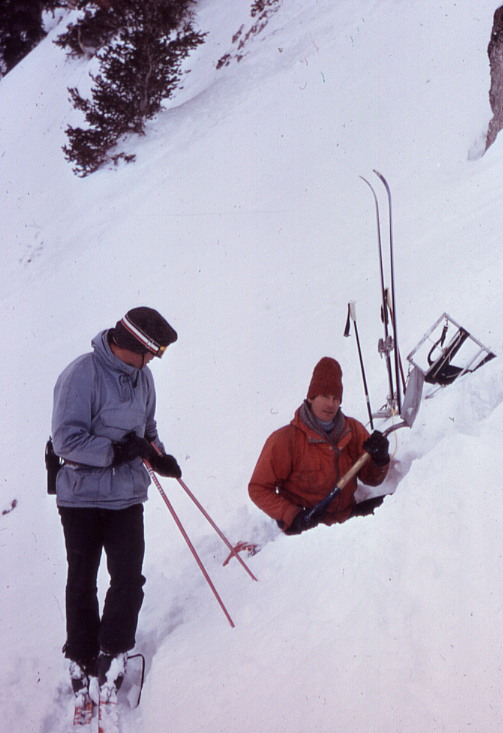Overview
This avalanche season marks 50 years of operations for the Colorado Avalanche Information Center. CAIC got its start as the Colorado Avalanche Warning Program (CAWP) in 1973 as part of the Forest Service’s Rocky Mountain Research Station. This was the first program in the US that issued public avalanche forecasts. Today, CAIC remains a leader in avalanche safety, research, and education.
The Evolution of Forecasting
CAIC’s forecasting model has changed over the years in response to the continuously growing need for more and better information as backcountry recreation and the number of avalanche incidents increased. The organization started with a central forecasting model: A main office in Fort Collins was staffed while field data for a larger area was collected by a network of observers. As the need for higher quality information grew, the organization transitioned to a hybrid forecasting model, maintaining a central role but with staff actually stationed throughout the forecast area. By the 1990s, remote offices were opened in Silverton, Eisenhower, Pagosa, and Marble as part of the highway forecasting program with CDOT. Today, the CAIC maintains its hybrid model with an office at the National Weather Station—now located in Boulder—but most staff work remotely, close to the mountains where they conduct field work instead of reporting to brick and mortar officers.
The forecasts themselves have changed over time as well. CAWP issued statewide alerts of dangerous avalanche conditions at different times during the day based on conditions and media exposure. In the 1990s, CAIC started issuing avalanche forecasts for three forecast zones: the Northern Mountains, the Central Mountains, and the Southern Mountains. In 2006, these three zones were split into the ten zones we used and issued forecasts for up until 2022. At the beginning of the 2022-23 season, we switched from the 10 predefined zones to dynamic zones; this allows forecasters to highlight areas with similar avalanche conditions rather than describing conditions in fixed regions.
Information Sharing
In the beginning, forecasts were disseminated via teletype and the hotline even primarily to ski resorts, the National Weather Service, and major news outlets. With the advent of new technologies, CAIC added additional modes to share the daily forecast, including an email newsletter starting in 1996, and the website, which was launched in 1997. Forecasts even used to be shared via fax. Hotline use plummeted as people adopted the internet, and the decline continued as people began relying on mobile technology. In 2014, CAIC discontinued the six hotlines and began posting forecast recordings to the website.
The Advancement of Snow Science
CAIC staff have been integral in advancing avalanche and snow science. Prior to founding CAWP, Art Judson started the Westwide Avalanche Network, which collected avalanche data across 12 states. Many of the researchers and staff at the San Juan Avalanche Project in the early 1970s would go to work for the CAIC. Former CAIC Director Knox Williams authored the second volume of Snowy Torrents in 1975, which was the first volume to include statistical analysis of accident patterns. CAIC staff were primary authors on the four subsequent volumes, and numerous studies of avalanche accident patterns. CAIC hosted the first Colorado Snow and Avalanche Workshop in 2002. This model of regional workshops would spread around the country and become a vital resource for avalanche workers. In the early 2000s, CAIC forecaster Dale Atkins was among several scientists and educators who applied modern decision-making theory and psychology to the “human factors” of avalanche accidents. As the CAIC’s capacity increased in the 2010s, forecasters took on additional research topics, including weather and snowpack modeling, avalanche and accident patterns, and communication design. For the 2023 International Snow Science Workshop, CAIC staff co-authored 15 research papers on topics ranging from propagation speeds to forecast verification to stress mitigation in avalanche workers.
Highway Forecasting
CAIC joined the Colorado Department of Transportation’s highway safety program in 1993 following the death of a CDOT worker in an avalanche on Red Mountain Pass. This partnership made CAIC the only avalanche center in the country that forecast for both the backcountry and highways.
Only Avalanche Center in State Government
CAIC has been housed within different agencies and programs since its inception. In 1983, as a result of downsizing, CAWP lost its federal funding and home within the Forest Service. At that time, the Colorado Department of Natural Resources saw the value in avalanche forecasting for its other operations and agreed to house the program in its Executive Directors Office. Just four years later, CAIC moved into the Colorado Geological Survey under DNR when statute defined avalanches as a geologic hazard. CAIC moved back under DNR-EDO in 2013 and has been there ever since. One thing to note about the organization’s landing spot within DNR is that it is the only avalanche center in the country that resides within state government – instead of under the Forest Service in the federal government or as a non-profit.
CAWP started with two employees. In 1983, when the program officially became the CAIC, it had three employees, a budget of $70,000, and one office and issued forecasts twice a day - in the morning and afternoon. By 2014, CAIC had grown to a team of 17 and was, as of 2008, issuing forecasts for ten set zones each morning. CAIC has now grown to 33 staff members.



